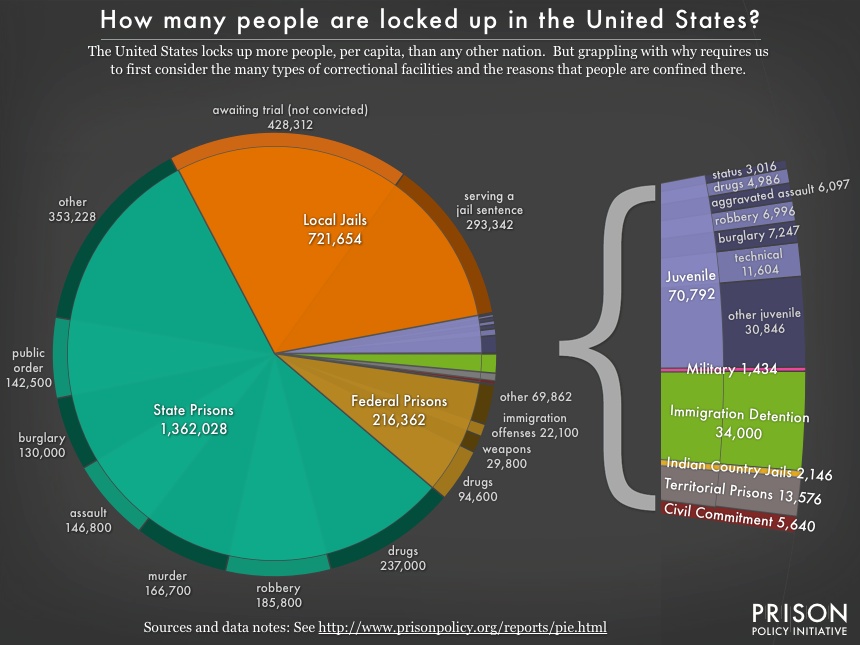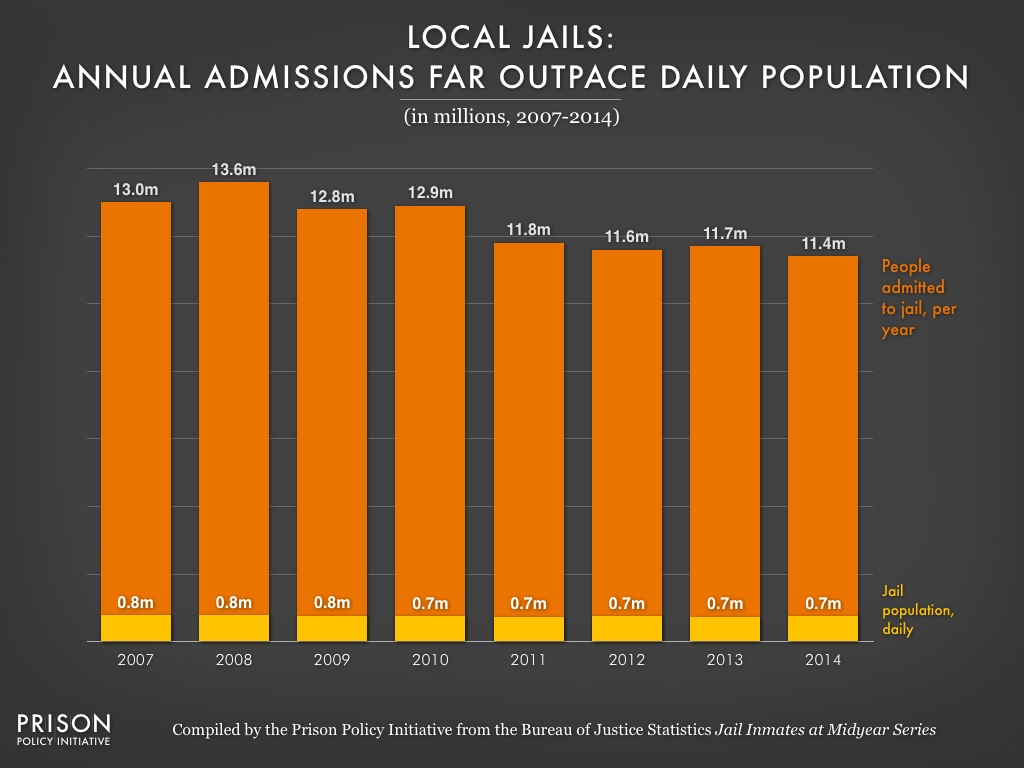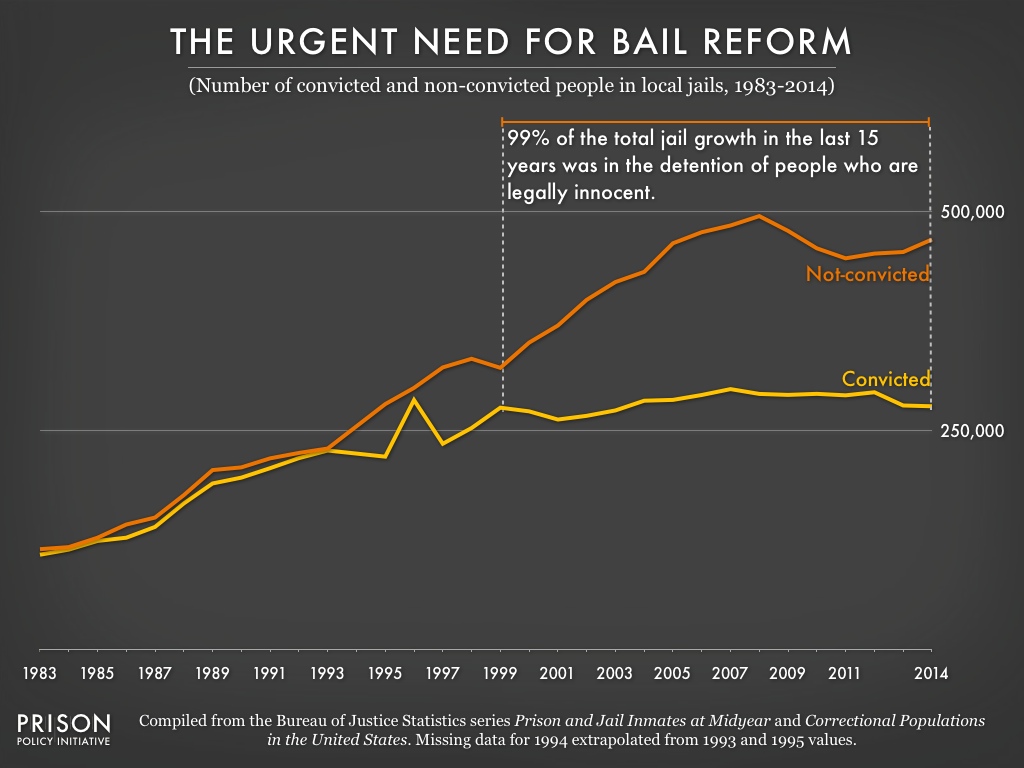Jails matter. But who is listening?
Most of the people who go to prison or jail in a year go to jail, so why don't policymakers pay more attention to jails?
by Peter Wagner, August 14, 2015
 One out of every three people who are locked up tonight are sitting in a local jail, not a state or federal prison. There are 3,283 jails in America, yet jails receive scant attention. The legislative, judicial and executive decisions that have fueled the explosion of our state prison populations are becoming well-known; but the myriad of subtle policy decisions that have sent our jail populations upwards are off the public’s radar.
One out of every three people who are locked up tonight are sitting in a local jail, not a state or federal prison. There are 3,283 jails in America, yet jails receive scant attention. The legislative, judicial and executive decisions that have fueled the explosion of our state prison populations are becoming well-known; but the myriad of subtle policy decisions that have sent our jail populations upwards are off the public’s radar.
Jails need to be a policy focus, as the Vera Institute of Justice recently argued in its aptly-titled report Incarceration’s Front Door: The Misuse of Jails in America.
Jails matter because a staggering 11 million people cycle through them each year. As we explained last year:
Jail churn is particularly high because at any given moment most of the 722,000 people in local jails have not been convicted and are in jail because they are either too poor to make bail and are being held before trial, or because they’ve just been arrested and will make bail in the next few hours or days. The remainder of the people in jail — almost 300,000 — are serving time for minor offenses, generally misdemeanors with sentences under a year.
So when we talk about jails we have to keep our eye on two numbers: the number of people in jail on a given day and the sheer volume of people who cycle through them as shown in this analysis of Bureau of Justice Statistics data:
 Addressing the problem of jails means grappling with the tremendous churn through jails. How can we lessen the numbers who enter jails and reduce the time that 11 million people spend there each year?
Addressing the problem of jails means grappling with the tremendous churn through jails. How can we lessen the numbers who enter jails and reduce the time that 11 million people spend there each year?
This “pre-trial” or “unconvicted” population is driving the growth in jail populations. In fact, 99% of the growth in jails over the last 15 years has been a result of increases in the pre-trial population:
 Virtually all of the growth in the jail population has been in the number of legally innocent people who are detained in jails.
Virtually all of the growth in the jail population has been in the number of legally innocent people who are detained in jails.
These people are legally considered innocent until proven otherwise in court. But if they don’t have the money to post bail, the principle that they are legally innocent is not enough to keep them from being locked up until trial. A recent New York Times feature found that poverty is a frequent cause of pre-trial detention: in New York City even when bail is set at $500 or less, 85% of defendants were unable to afford bail.
Besides the injustice of our jails resembling modern day debtor’s prisons, excessive bail can have other harmful effects. Family life is disrupted, jobs and housing can be lost, and the combined effects can literally be fatal. Pre-trial detention also coerces people to plead guilty to minor offenses, including people who are factually innocent like the man featured in the New York Times article. Studies have also shown that people who are detained pretrial are more likely to be convicted than those who are able to afford bail.
Fortunately, the movement for bail reform is growing in places like New York City and the state of Massachusetts. But at the same time as we work to fix bail, we really should admit that the problem starts even before a bail hearing.
As Peter Goldberg, executive director of the Brooklyn Community Bail Fund put it in the New York Times article:
And the truth is, even meaningful bail reform is just the beginning. The real work is asking why we’re arresting so many people on low-level offenses in the first place, and why so many of them come from poor black and brown communities. Bail is easy.
Or to be more precise: fixing bail should be easy. Why it’s taking so long is a good question and getting to the bottom of this country’s jail problem is going to depend on both reducing the number of people we send to jail each year and making it far easier for those who have been arrested to resume their lives while the judicial process proceeds.




[…] The growth of the unconvicted jail population and why jails can’t be ignored. (99% of the growth in jails in the last 15 years resulted from increases in the number of people who are not convicted) […]
Many of the people sitting in jails are there because of the incompetence of a public employee, a prosecutor or an uninformed Grand Jury. Sometimes all of the above! Plus you can probably add greed, benefits and revenue. All have broken their Oath of Office.
[…] the private bail industry keeps legislatures from passing sensible bail reforms that would allow poor, unconvicted people who pose no public safety threat to wait for their trial at home rather than in […]
[…] Jails matter. Their policies might be set by 3,000 local governments, which can make them hard to follow and understand. But we need to look at jails, which are literally mass incarceration’s front door. […]
[…] by the criminal justice system. In addition to the 636,000 people released from prisons each year, over 11 million people cycle through local jails each year. Jail churn is particularly high because at any given moment a majority of the people in local […]
[…] by the criminal justice system. In addition to the 636,000 people released from prisons each year, over 11 million people cycle through local jails each year. Jail churn is particularly high because at any given moment a majority of the people in local […]
[…] by the criminal justice system. In addition to the 636,000 people released from prisons each year, over 11 million people cycle through local jails each year. Jail churn is particularly high because at any given moment a majority of the people in local […]
[…] by the criminal justice system. In addition to the 636,000 people released from prisons each year, over 11 million people cycle through local jails each year. Jail churn is particularly high because at any given moment a majority of the people in local […]
[…] by providing defendants with lawyers at bail hearings. Pre-trial detention makes up for 99% of the incarceration growth in the last fifteen years. A randomized control study in Baltimore, Maryland found that by giving […]
[…] year, 636,000 people walk out of prison gates, but people go to jail over 11 million times each year, 451,000 people in jails haven’t even been […]
[…] Every year, 636,000 people walk out of America’s numerous prisons, but 11 million people cycle through our jails each year! […]
[…] made a graph for his article Jails matter. But who is listening?, and an animated version for the Detaining the Poor: How money bail perpetuates an endless cycle of […]
[…] Peter Wagner, Jails Matter. But Who Is Listening?, PRISON POL’Y INITIATIVE (Aug. 14, 2015), https://www.prisonpolicy.org/blog/2015/08/14/jailsmatter [https://perma.cc/JD33-5F7Q] (compiling data retrieved from the Bureau of Justice Statistics’ […]